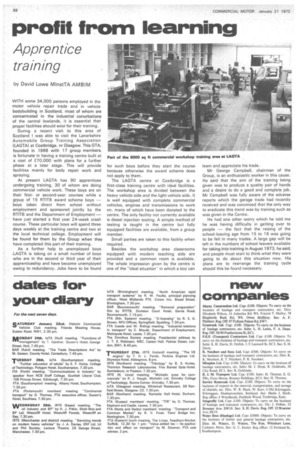profit from earning
Page 60

If you've noticed an error in this article please click here to report it so we can fix it.
Apprentice training
by David Lowe WilnstTA AMB1M
WITH some 34,000 persons employed in the motor vehicle repair trade and in vehicle bodybuilding in Scotland, most of whom are concentrated in the industrial conurbations of the central lowlands, it is essential that proper facilities should exist for their training.
During a recent visit to this area of Scotland I was able to visit the Lanarkshire Automobile Group Training Association {LAGTA) at Coatbridge, nr Glasgow. This GTA, founded in 1968 with 17 group members. is fortunate in having a training centre built at a cost of £70,000 with plans for a further phase at a later stage. This will provide facilities mainly for body repair work and spraying.
At present LAGTA has 90 apprentices undergoing training, 30 of whom are doing commercial vehicle work. These boys are on their firstor second-year courses while a group of 15 RTITB award scheme boys boys taken direct from school without employment and sponsored jointly by the RTITB and the Department of Employment have just started a first year 24-week crash course. These particular boys will spend three days weekly at the training centre and two at the local technical college. Employment will be found for them by the Group when they have completed this part of their training.
As a further help to unemployed boys .LAGTA is taking on a small number of boys who are in the second or third year of their apprenticeship and have become unemployed owing to redundancy. Jobs have to be found for such boys before they start the course because otherwise the award scheme does not apply to them.
The LAGTA centre at Coatbridge is a first-class training centre with ideal facilities. The workshop area is divided between the heavy vehicle side and the light vehicle side. It is well equipped with complete commercial vehicles, engines and transmissions to work on, many of which have been donated to the centre. The only facility not currently available is diesel injection testing. A simple method of testing is taught in the centre but fully equipped facilities are available, from a group member.
Small parties are taken to this faeility when required.
Besides the workshop area classrooms equipped with modern teaching aids are provided and a common room is available. The whole impression given by the centre is one of the "ideal situation" in which a boy can learn and appreciate his trade.
Mr George Campbell, chairman of the Group, is an enthusiastic worker in this cause. He said that the aim of the training being given was to produce a quality pair of hands and a desire to do a good and complete job. Mr Campbell was fully aware of the adverse reports which the garage trade had recently received and was convinced that the only way to eradicate this trend was by training such as was given in the Centre.
He had one other worry which he told me he was having difficulty in getting over to people the fact that the raising of the school-leaving age from 15 to 16 was going to be felt in many trades. A large gap will be left in the numbers of school leavers available for taking into training in August 1973, he said, and people must start to think what they were going to do about this situation now. His plans are to rearrange the training cycle should this be found necessary.










































































































